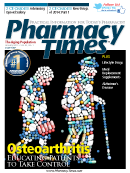Publication
Article
Pharmacy Times
Case Studies (January 2015)
CASE 1
While working at the pharmacy, you (the pharmacist) receive an electronically submitted prescription for prazosin 10 mg, in the evening, for a patient with the initials JP. JP is a 30-year-old man who has been coming to your pharmacy since he was a child. JP is in the military and was recently stationed in Afghanistan for over a year. He returned a few months ago. You check his profile and see he is currently taking tramadol and ibuprofen on an as-needed basis, and sertraline 100 mg once daily. You know JP is in excellent physical shape and doubt that he is being prescribed prazosin for hypertension (since alpha-blockers are not preferred for treating hypertension) or benign prostatic hyperplasia (because of his young age).
Why do you think JP is receiving prazosin?
CASE 2
WW is a 50-year-old man newly diagnosed with HIV-1 infection. He comes to the pharmacy with 2 new prescriptions: one for tenofovir, and another for emtricitabine. He looks worried and says, “I think I may have somehow misplaced a prescription.” WW admits he is unsure what the prescription was for.
What drug is WW’s missing prescription most likely for?
ANSWERS
Case 1: While it is an off-label use, prazosin has been shown to be effective in reducing nightmares associated with posttraumatic stress disorder (PTSD). Guidelines published by the Veterans Administration/Department of Defense and the American Academy of Sleep Medicine recommend the use of prazosin as an adjunctive therapy to reduce the incidence of nightmares in patients with PTSD. It is important to note that use of prazosin as monotherapy for PTSD is discouraged; prazosin should only be used as adjunctive therapy to control nightmares.
Case 2: Antiretroviral therapy (ART) for HIV/AIDS is composed of at least 3 different antiretroviral agents: at least 2 are nucleoside reverse transcriptase inhibitors (NRTIs), and the third drug has another unique mechanism. Tenofovir and emtricitabine are NRTIs and make up the “backbone” of many recommended first-line ART regimens. The National Institutes of Health recommends the following non-NRTIs agents in addition to tenofovir and emtricitabine for antiretroviral-naive patients:
- Efavirenz (EFV) (available as a single pill; Atripla)
- Rilpivirine (only for patients with a CD4 count >200 cells/mm3)
- Protease inhibitor—based therapy
- Ritonavir-boosted atazanavir
- Ritonavir-boosted darunavir Integrase nuclear strand transfer inhibitor—based therapy
- Dolutegravir
- Raltegravir
- Elvitegravir/cobicistat (EVG/cobi) (only for patients with pre-ART creatinine clearance >30 mL/min; available as a single pill; Stribild)
Of these, the EFV and EVG/cobi (+TDF/FTC) regimens are available as once-daily combined tablets, making them unlikely to be WW’s missing prescription
function showAnswer() {document.getElementById("answer").style.display = 'block';document.getElementById("link").style.display = 'none';}
David Li is a PharmD candidate at the University of Connecticut School of Pharmacy. Dr. Coleman is professor of pharmacy practice, as well as co-director and methods chief at Hartford Hospital Evidence-Based Practice Center, at the University of Connecticut School of Pharmacy.







